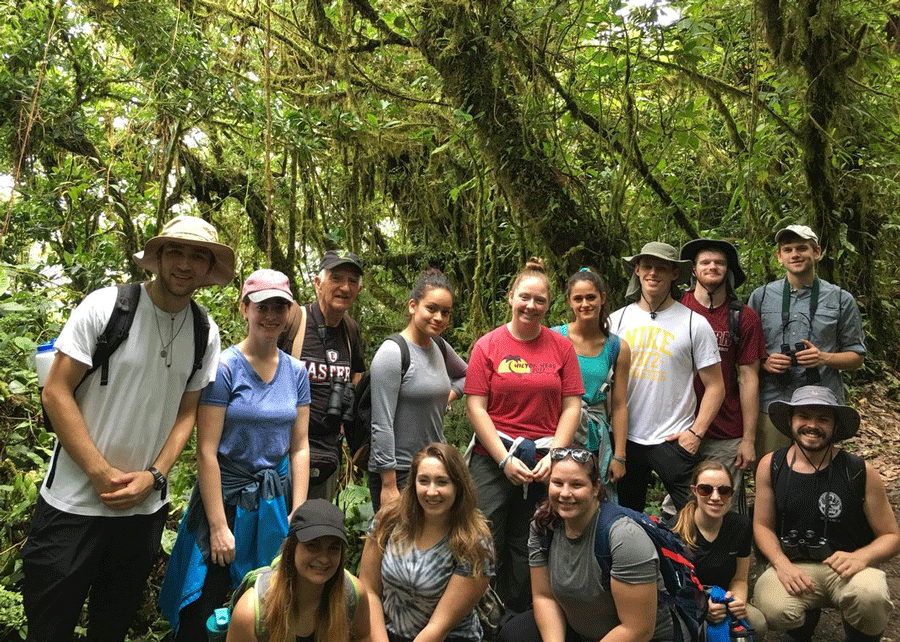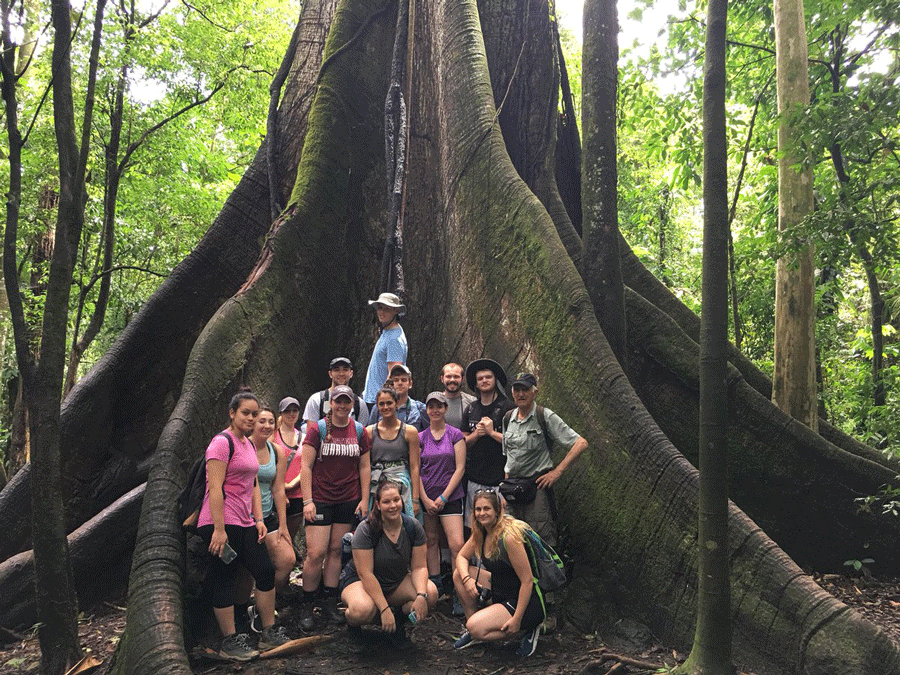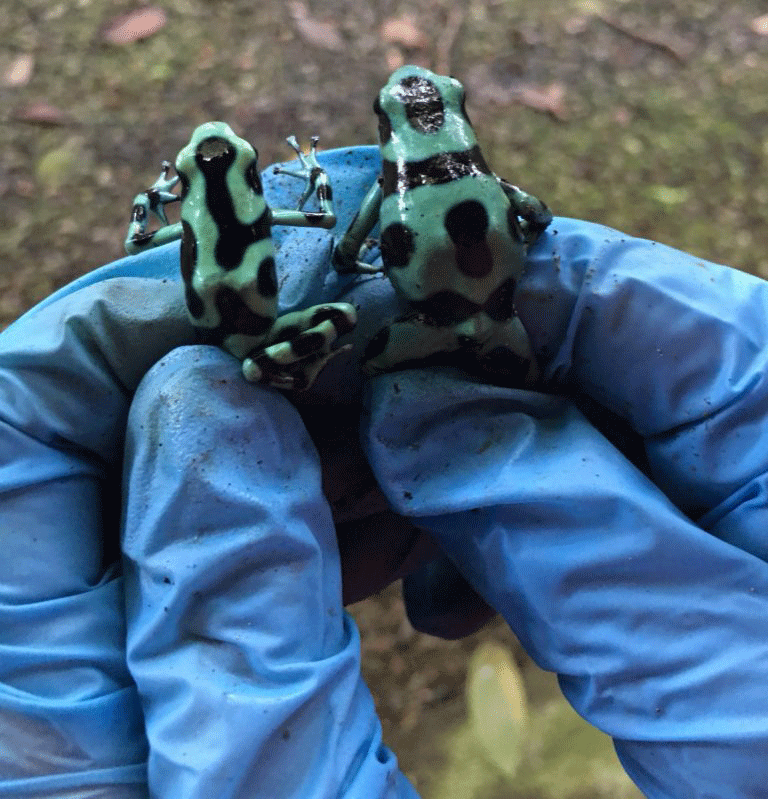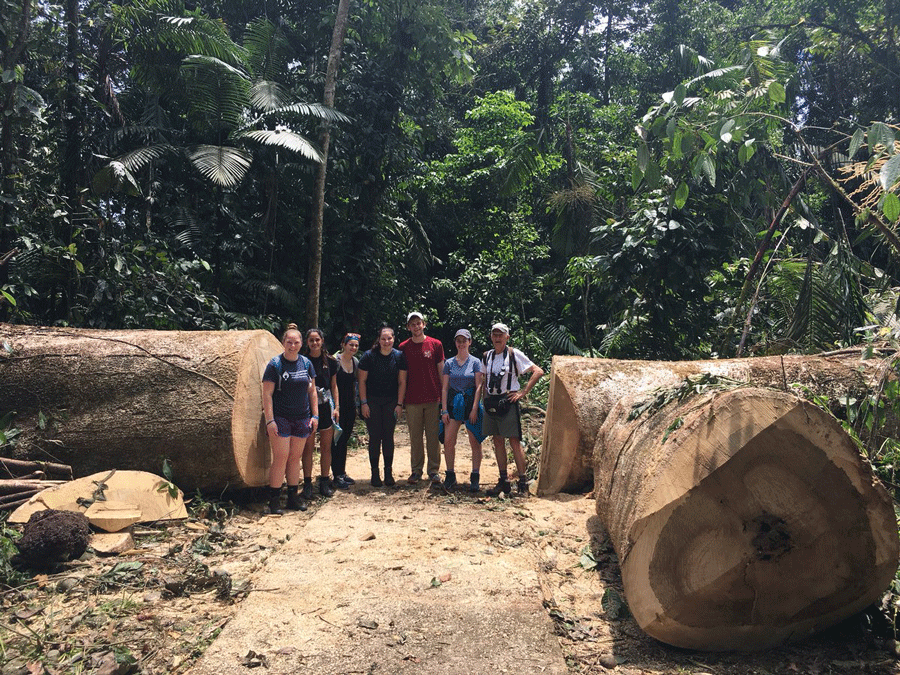- Apply
- Visit
- Request Info
- Give
Students Study within Jungles of Costa Rica
Written by Dwight Bachman
Published on August 15, 2018

On May 20, 14 Eastern Biology students and professors Patricia Szczys and Matthew Graham traveled to Costa Rica to conduct research in that country’s tropical forests.
The group hiking in Arenal Volcano National Park, the ceiba tree is estimated to be 300 years old and sporting iconic rainforest tree butresses.
The group had been planning the 12-day trip since January, using the spring semester to read scientific literature and prepare research proposals for studies they would conduct while in Costa Rica.
Male (left) and Female (right) Green and Black Poison Dart frog Dendrobates auratus, the focus of two student research projects this year.
During six days in the humid lowland rainforest at Selva Verde, the students completed experiments on leaf-cutter ant foraging strategies; individual recognition cues by the strawberry poison-dart frog; effectiveness of aposematic warning colors and patterns in snakes; population density and sex ratio of the green and black poison-dart frog; and avian predator avoidance behavior by poison frogs. Several of these experiments will be presented at undergraduate research conferences during this coming academic year.

“The experiences and knowledge that I have gained during my eleven days in Costa Rica on Eastern’s Tropical Biology Global Field Course were invaluable,” said Murphy’ 20. “Not only did the trip allow me to see and explore places I’d never imagined seeing, but it also allowed our whole class to perform scientific research projects that involved real world data collection and experimentation that would not be possible in the United States.”
Students stand near a tree recently cleared from the trail. On Saturday, May 19, tornado-like winds damaged the forest at the La Selva Research Station in Costa Rica, toppling hundreds of trees, several canopy research platforms, and changing the forest for 100 years or more. This tree is probably more than 200 years old.
“The Costa Rica trip was absolutely unforgettable, not only for the invaluable in-field experience gained, but, additionally, for the mutually shared memories that I made with my classmates and professors that I’ll remember forever, said Kukla ’19. “I am grateful to Eastern, as this opportunity has definitely sparked a permanent interest in Rain Forest Biology. The biggest thank you must be given to Dr. Szczys and Dr. Graham for constantly answering all of our questions, pointing out small details that could easily be missed, and lastly, just being amazing professors who inspired us as students throughout the entire trip.”

In addition to their research, the group spent time hiking, observing animals and identifying plants that interact to produce the rich biodiversity of the tropical rainforest. The group visited the world-renowned La Selva Biological Research Station; toured an organic export-oriented pineapple plantation; hiked the lava fields at Arenal Volcano National Park; toured the Don Juan coffee plantation; and hiked to the Continental Divide in the Monteverde Cloud Forest Reserve.
“This trip was so valuable to me because it forced me to come out of my comfort zone in all the best ways,” said Pinto’19. “It’s not every day that you can say you conducted your own research in such a beautiful place filled with amazing biodiversity!”

The Tropical Biology course and field trip to Costa Rica is offered in alternating spring semesters and fulfills an upper-level course requirement for Biology majors. In other years, biology students travel to San Salvador, Bahamas, continuing the Biology Department’s tradition of offering the Tropical Biology course every year since 1968. Professor Szczys has been leading groups to Costa Rica since it replaced Belize as the course location in 2008 and Professor Graham joined in 2016. “This year’s students were especially excited to celebrate the 50th anniversary of the Tropical Biology program at Eastern,” said Szczys


